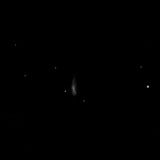
| MESSIER 102 |
|---|
RA: |
15h 06m 30s |
|
DEC: |
+55° 46' 00'' |
|
Type: |
Lenticular galaxy |
|
NGC: |
5866 |
|
Magnitude: |
9.90 |
|
Surface brightness : |
12.20 |
|
Apparent dimensions : |
6.5'x3.1' |
|
Distance: |
45,000,000 ly |
|
NGC 5866 is a beautiful lenticular galaxy in Northern constellation Draco, which is seen almost exactly edge-on, showing a prominent dust lane along its equatorial plane. It is prominent for being a good candidate for Messier Object 102. NGC 5866 was probably first seen by Pierre Méchain in March 1781, or by Charles Messier shortly after that time. Therefore, NGC 5866 is possibly M102, although Pierre Méchain disclaimed the discovery two years later. Pierre Méchain's first observing report caused Messier to include it as entry No. 102 in his catalog, without giving a position or further verification. Soon after, Messier added a position measurement for this object (or entry) to his personal copy of the catalog, probably shortly after publication, and still in 1781. There is evidence that Charles Messier has probably observed NGC 5866 when measuring this position, as this is almost exactly 5 degrees preceding (west) of the actual position of the object: Very probably a data reduction error of some kind. Nevertheless, this subject is still somewhat dubious and therefore controversial. If, despite this evidence, it should be true that neither Méchain nor Messier have observed NGC 5866, it was probably first seen by William Herschel when independently discovering it in 1788; William Herschel determined its position on May 5, 1788. As the possible earlier sightings by Méchain and Messier did not result in a published position for this object, this galaxy bears Herschel's number H I.215. NGC 5866 is a beautiful lenticular galaxy of visual magnitude 9.9, according to newer references. It is seen almost exactly edge-on. The distance of NGC 5866 is estimated at 45 million light-years. At this distance, its diameter of 5.3' corresponds to a linear extension of about 69,000 light-years. This galaxy is the brightest member of a remarkable group of galaxies, the NGC 5866 group or M102 group of galaxies. This group also contains the big and bright edge-on spiral NGC 5907 (type Sb+, 10.4 mag vis), the fainter galaxy NGC 5879 (Sb, 11.5), and more very faint galaxies. NGC 5866 can be found rather easily, and along the description given by Méchain despite his disclaimer, from Iota Draconis (Edasich, mag 3.29, spectral type K2 III), about 3 deg SW in the direction of Eta Ursae Majoris (Alkaid, mag 1.9, sp B3 III) or Theta Bootis (mag 4.06, sp F7 V); a star of mag 5.21 (GC 20332 = HD 134190 = SAO 29407) is nearby and to the south. This galaxy is well visible in a 4-inch telescope as a considerably bright elliptical or spindle-shaped nebulous object with a brighter core, notable even in smaller instruments; several faint stars are visible around it. Larger telescopes show more details, in particular the dust lane and the brighter ends, and a mottled or grainy texture of the outer parts of the galaxy. |
||
VEDRAN VRHOVAC© 2006.-2007. |
